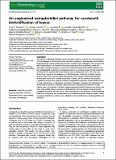Por favor, use este identificador para citar o enlazar a este item:
http://hdl.handle.net/10261/241022COMPARTIR / EXPORTAR:
 SHARE SHARE
 CORE
BASE CORE
BASE
|
|
| Visualizar otros formatos: MARC | Dublin Core | RDF | ORE | MODS | METS | DIDL | DATACITE | |

| Título: | An engineered extraplastidial pathway for carotenoid biofortification of leaves |
Autor: | Andersen, Trine CSIC ORCID; Llorente, Briardo CSIC ORCID; Morelli, Luca CSIC ORCID; Torres-Montilla, Salvador CSIC ORCID CVN; Bordanaba‐Florit, Guillermo CSIC; Espinosa, Fausto A. CSIC; Rodríguez‐Goberna, María Rosa CSIC; Campos, Narciso CSIC ORCID; Olmedilla-Alonso, Begoña CSIC ORCID ; Llansola‐Portoles, Manuel J.; Pascal, Andrew A.; Rodriguez-Concepcion, Manuel CSIC ORCID | Fecha de publicación: | 2021 | Editor: | Wiley-VCH | Citación: | Plant Biotechnology Journal 19(5): 1008-1021(2021) | Resumen: | Carotenoids are lipophilic plastidial isoprenoids highly valued as nutrients and natural pigments. A correct balance of chlorophylls and carotenoids is required for photosynthesis and therefore highly regulated, making carotenoid enrichment of green tissues challenging. Here we show that leaf carotenoid levels can be boosted through engineering their biosynthesis outside the chloroplast. Transient expression experiments in Nicotiana benthamiana leaves indicated that high extraplastidial production of carotenoids requires an enhanced supply of their isoprenoid precursors in the cytosol, which was achieved using a deregulated form of the main rate‐determining enzyme of the mevalonic acid (MVA) pathway. Constructs encoding bacterial enzymes were used to convert these MVA‐derived precursors into carotenoid biosynthetic intermediates that do not normally accumulate in leaves, such as phytoene and lycopene. Cytosolic versions of these enzymes produced extraplastidial carotenoids at levels similar to those of total endogenous (i.e. chloroplast) carotenoids. Strategies to enhance the development of endomembrane structures and lipid bodies as potential extraplastidial carotenoid storage systems were not successful to further increase carotenoid contents. Phytoene was found to be more bioaccessible when accumulated outside plastids, whereas lycopene formed cytosolic crystalloids very similar to those found in the chromoplasts of ripe tomatoes. This extraplastidial production of phytoene and lycopene led to an increased antioxidant capacity of leaves. Finally, we demonstrate that our system can be adapted for the biofortification of leafy vegetables such as lettuce. | Versión del editor: | https://doi.org/10.1111/pbi.13526 | URI: | http://hdl.handle.net/10261/241022 | DOI: | 10.1111/pbi.13526 | E-ISSN: | 1467-7652 |
| Aparece en las colecciones: | (IBMCP) Artículos (CRAG) Artículos (ICTAN) Artículos |
Ficheros en este ítem:
| Fichero | Descripción | Tamaño | Formato | |
|---|---|---|---|---|
| engileave.pdf | 3,11 MB | Adobe PDF |  Visualizar/Abrir |
CORE Recommender
PubMed Central
Citations
8
checked on 28-abr-2024
SCOPUSTM
Citations
18
checked on 02-may-2024
WEB OF SCIENCETM
Citations
16
checked on 25-feb-2024
Page view(s)
104
checked on 07-may-2024
Download(s)
126
checked on 07-may-2024

